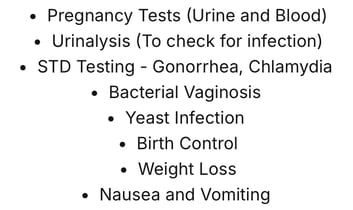

Women's Health
Easy, Quick, & Discrete Treatment
Pregnancy Tests (Urine or Blood)
Urinalysis (Check for infection)
STD Testing - Gornorrhea, Chlamydia
Bacterial Vaginosis
Yeast infection
Birth Control
Weight Loss
Nausea & Vomiting
Urinary Tract Infections in Women
Urinary tract infections (UTIs) are most often caused by bacteria. These bacteria enter the urinary tract. The bacteria may come from inside the body. Or they may travel from the skin outside the rectum or vagina into the urethra. Female anatomy makes it easy for bacteria from the bowel to enter a person’s urinary tract. This is the most common source of UTIs. This means women develop UTIs more often than men.
Pain in or around the urinary tract is a common UTI symptom. But the only way to know for sure if you have a UTI is for the healthcare provider to test your pee. The two tests that may be done are the urinalysis and urine culture. These tests tell your provider if you have a UTI and what type of bacteria is causing it.
Types of UTIs
• Cystitis. A bladder infection (cystitis) is the most common UTI in women. You may have an urgent or frequent need to pee. You may also have pain, burning when you pee, and bloody urine.
• Urethritis. This is an inflamed urethra. This is the tube that carries urine from the bladder to outside the body. You may have lower stomach or back pain. You may also have an urgent or frequent need to pee.
• Pyelonephritis. This is a kidney infection. It can be serious and damage your kidneys if not treated. You may need to stay in the hospital in severe cases. You may have a fever and lower back pain.
Medicines to treat a UTI
Most UTIs are treated with antibiotics. These kill the bacteria. The length of time you need to take them depends on the type of infection. It may be as short as 3 days. Take antibiotics exactly as directed. Don’t stop taking them until all of the medicine is gone, even if you feel better. The infection may not go away fully and return if you stop taking the antibiotic.
• Follow up with your healthcare provider as directed. They may test to make sure the infection has cleared. If needed, more treatment may be started.


